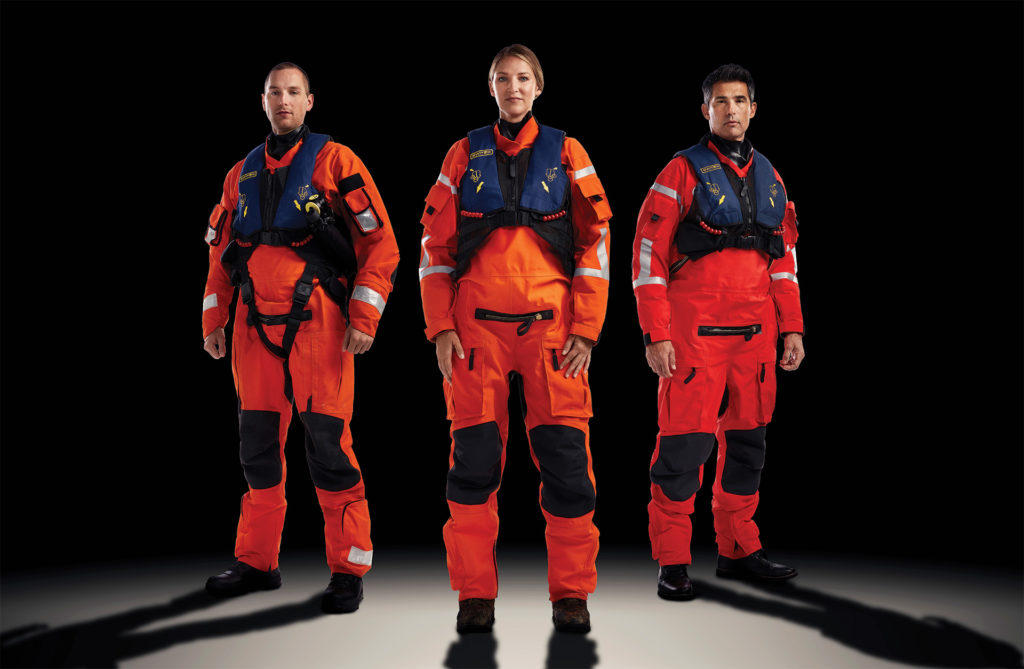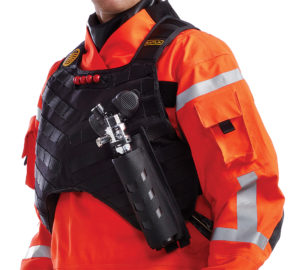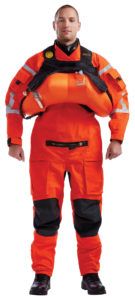Many years ago, when the engineers and product designers at Switlik Survival Products first encountered underarm flotation technology, they saw it as an ideal mechanism to someday replace the bulky, yoke-style life vests that helicopter crews wear while flying over water.

By placing flotation devices under a pilot’s arms instead of in a yoke around their necks, they could remain upright in the water rather than laying on their backs. They could also save space in the cockpit and improve maneuverability and peripheral vision.
“We try to make products that make a difference,” said Sarah Switlik, the company’s chief operating officer and a fourth-generation member of the Switlik family to guide the business. “We’ve always emphasized products that fall into the ‘need’ category that will be high performing and will get our customers out of whatever jam they find themselves in.”

With the launch of its new UA-80 Evolution vest at Heli-Expo 2022, Switlik brought its revolutionary underarm flotation technology to the civil helicopter industry for the first time.
“We really think this is going to be a game changer,” said Paul Arnold, director of commercial sales at Switlik Survival Products. “This is the next evolution of life vests.”
The UA-80 Evolution vest is the first commercially available underarm constant-wear life vest to be approved by the U.S. Federal Aviation Administration (FAA), and its durable inflatable bladder brings military-grade functionality to the civil market.

Like many Switlik products, the Evolution vest is rooted in a concept the company initially developed for military use — in this case, a next-generation life vest for the U.S. Army Aircrew Combat Equipment program.
“It was extensively reviewed by the U.S. Army, and it has passed in-water testing,” Arnold said. “That was our gateway into the commercial market.”
The UA-80 Evolution vest is designed to solve the two biggest challenges of traditional yoke-style life vests by improving comfort and mobility around the head and neck, and by maximizing cabin space with a less bulky inflatable design.
“The brilliance of this vest is its incredibly low profile,” Arnold said. “It has a relatively small footprint on the wearer, so it can be used with a harness as well.”

By foregoing the yoke design, the Switlik Evolution vest is said to completely eliminate the helmet interference and range of motion issues posed by older-style constant wear vests.
It also has auto-righting capability for unconscious aircrew, meaning the vest brings users into a stable, face-up position for unimpeded breathing.
In addition, the UA-80 Evolution vest has more than twice as many modular lightweight load-carrying equipment (MOLLE) loops as any previous Switlik design. Using these loops, the wearer can attach multiple life-saving accessories — including compressed air breathing systems, flares, lights, cell phone pockets, and many others.

“That front panel of the vest, with all the MOLLE loops and accessories on it, sits atop the inflated bladder,” Arnold said. “It’s all there right in front of them and fully accessible.”
The inflatable bladder also has a dual-chambered design, with three-layer film construction that is said to be more resistant to fire, abrasion, and puncturing than traditional life vest fabrics. Arnold said the company sees the Evolution vest as a natural fit for helicopter operators in the oil-and-gas industry, as well as law enforcement, fire departments, and search-and-rescue.
“I have snuck out samples to some pretty high-profile customers,” he said. “They have absolutely given us feedback that says this [product] functions, just as well as [we] said it was going to.”
The UA-80 Evolution vest is the latest example of more than a century of constant innovation from Switlik, which started out as a small canvas and leather manufacturing company.
Stanley Switlik incorporated the company in 1920 after immigrating to the United States from Poland, arriving at Ellis Island in 1907 as a 16-year-old “steerage” passenger. His company initially made golf bags, coal bags, collapsible hampers, and canvas bags, among other products, for the U.S. Post Office Department.
The company transitioned to serve pioneers in the aviation industry, including Amelia Earhart. Switlik manufactured pilot and gunner belts and flight clothing. It also became one of the world’s most respected and prolific parachute manufacturers, and a major parachute supplier to the U.S. military during the Second World War, the Korean War, and other subsequent conflicts.
When demand for parachutes waned in the 1960s and ’70s, Switlik developed new inflatable products with a focus on the commercial market — including FAA-approved life vests and life rafts. The company also manufactures life rafts for the U.S. Coast Guard, and continues to supply the U.S. military with various products, including anti-G suits and anti-exposure suits.
“We operate around three pillars: Quality, performance, and innovation,” said Switlik, who, along with her father and CEO Stan Switlik, serves in the company’s core leadership team.
“I want to continue making things that make a difference to people, things that people need,” she said. “We love what we do. It’s really important to us.”








